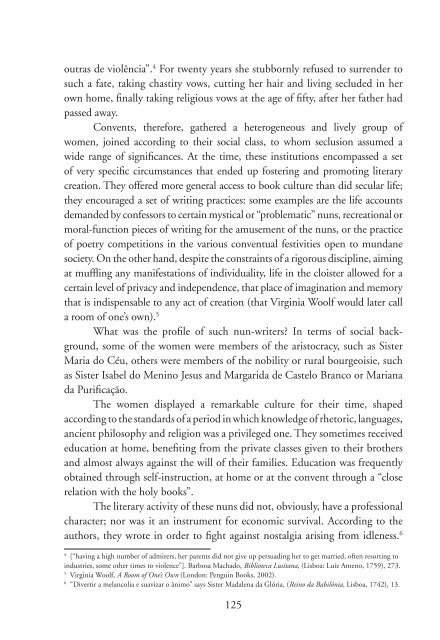Teaching Subjectivity. Travelling Selves for Feminist ... - MailChimp
Teaching Subjectivity. Travelling Selves for Feminist ... - MailChimp
Teaching Subjectivity. Travelling Selves for Feminist ... - MailChimp
Create successful ePaper yourself
Turn your PDF publications into a flip-book with our unique Google optimized e-Paper software.
outras de violência”. 4 For twenty years she stubbornly refused to surrender to<br />
such a fate, taking chastity vows, cutting her hair and living secluded in her<br />
own home, finally taking religious vows at the age of fifty, after her father had<br />
passed away.<br />
Convents, there<strong>for</strong>e, gathered a heterogeneous and lively group of<br />
women, joined according to their social class, to whom seclusion assumed a<br />
wide range of significances. At the time, these institutions encompassed a set<br />
of very specific circumstances that ended up fostering and promoting literary<br />
creation. They offered more general access to book culture than did secular life;<br />
they encouraged a set of writing practices: some examples are the life accounts<br />
demanded by confessors to certain mystical or “problematic” nuns, recreational or<br />
moral-function pieces of writing <strong>for</strong> the amusement of the nuns, or the practice<br />
of poetry competitions in the various conventual festivities open to mundane<br />
society. On the other hand, despite the constraints of a rigorous discipline, aiming<br />
at muffling any manifestations of individuality, life in the cloister allowed <strong>for</strong> a<br />
certain level of privacy and independence, that place of imagination and memory<br />
that is indispensable to any act of creation (that Virginia Woolf would later call<br />
a room of one’s own). 5<br />
What was the profile of such nun-writers? In terms of social background,<br />
some of the women were members of the aristocracy, such as Sister<br />
Maria do Céu, others were members of the nobility or rural bourgeoisie, such<br />
as Sister Isabel do Menino Jesus and Margarida de Castelo Branco or Mariana<br />
da Purificação.<br />
The women displayed a remarkable culture <strong>for</strong> their time, shaped<br />
according to the standards of a period in which knowledge of rhetoric, languages,<br />
ancient philosophy and religion was a privileged one. They sometimes received<br />
education at home, benefiting from the private classes given to their brothers<br />
and almost always against the will of their families. Education was frequently<br />
obtained through self-instruction, at home or at the convent through a “close<br />
relation with the holy books”.<br />
The literary activity of these nuns did not, obviously, have a professional<br />
character; nor was it an instrument <strong>for</strong> economic survival. According to the<br />
authors, they wrote in order to fight against nostalgia arising from idleness. 6<br />
4<br />
[“having a high number of admirers, her parents did not give up persuading her to get married, often resorting to<br />
industries, some other times to violence”]. Barbosa Machado, Biblioteca Lusitana, (Lisboa: Luiz Ameno, 1759), 273.<br />
5<br />
Virginia Woolf, A Room of One’s Own (London: Penguin Books, 2002).<br />
6<br />
“Divertir a melancolia e suavizar o ânimo” says Sister Madalena da Glória, (Reino da Babilónia, Lisboa, 1742), 13.<br />
125

















